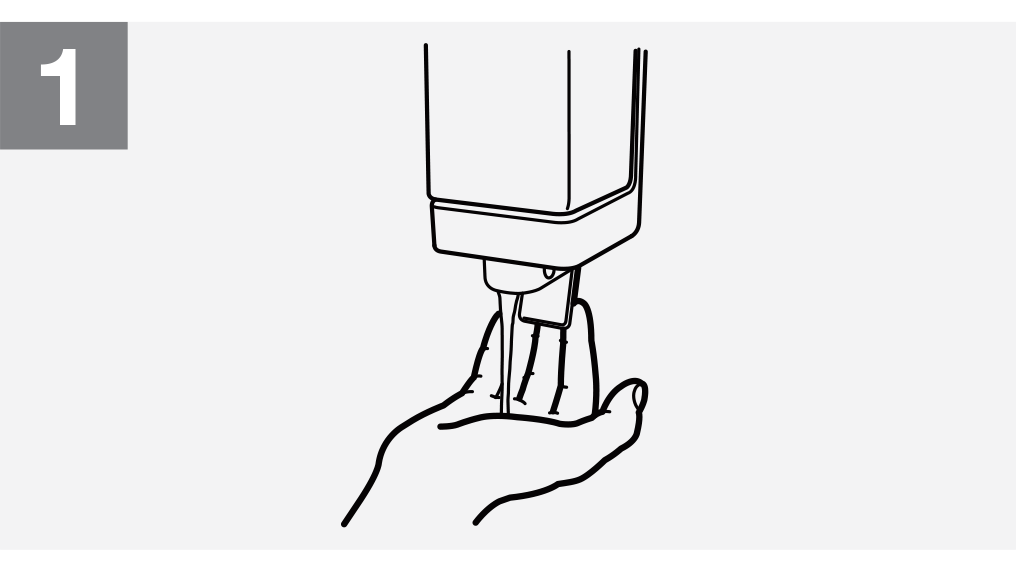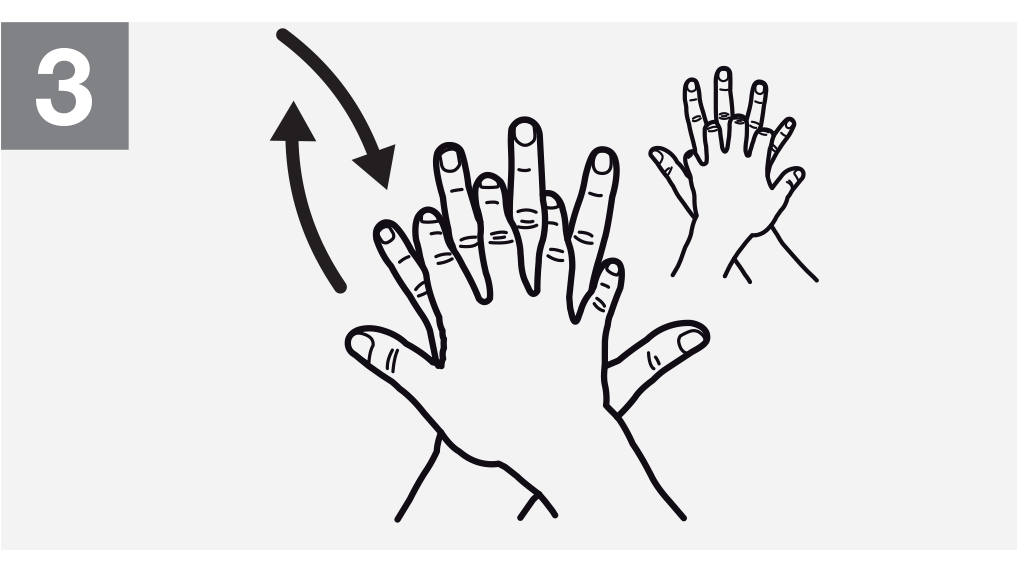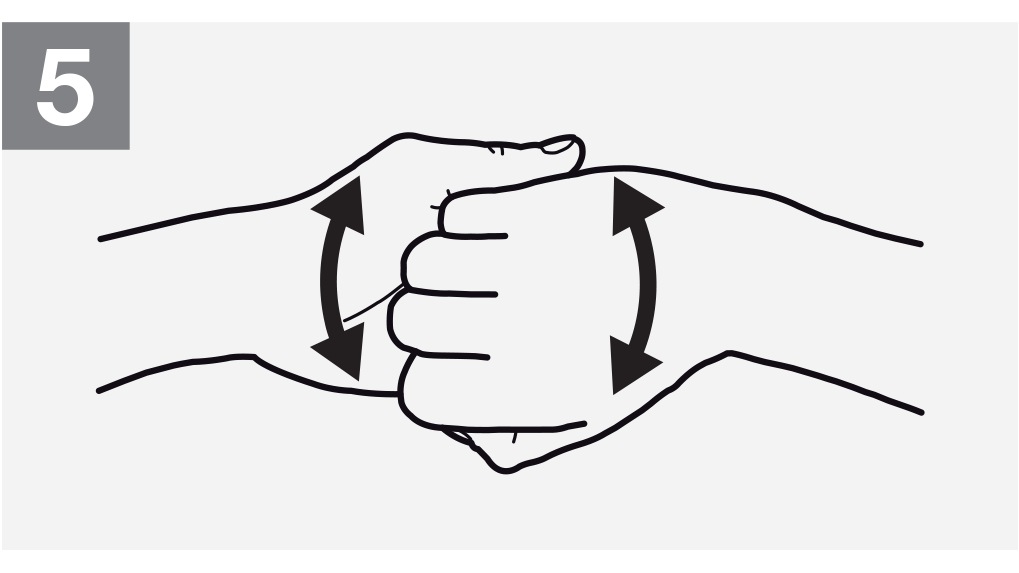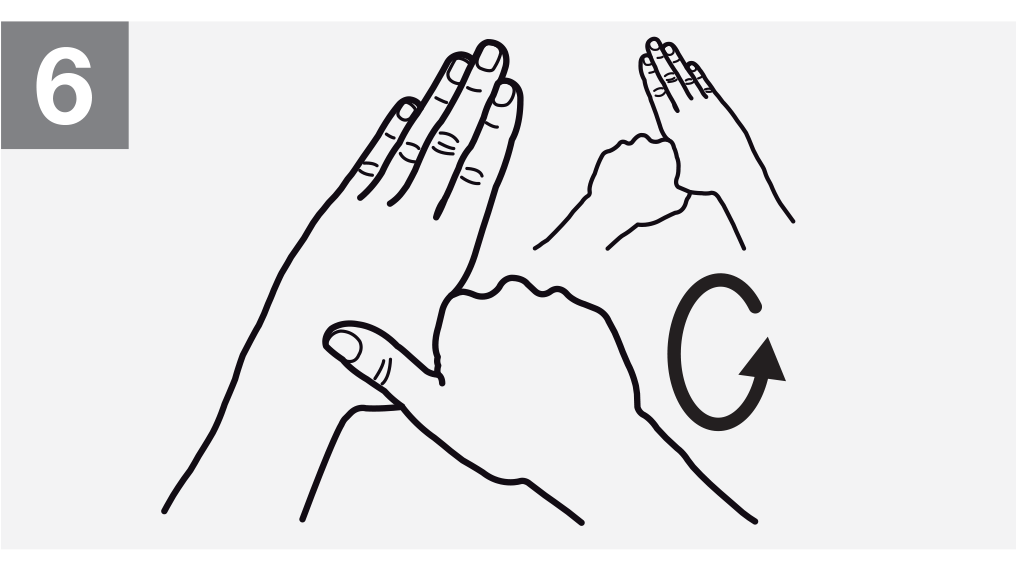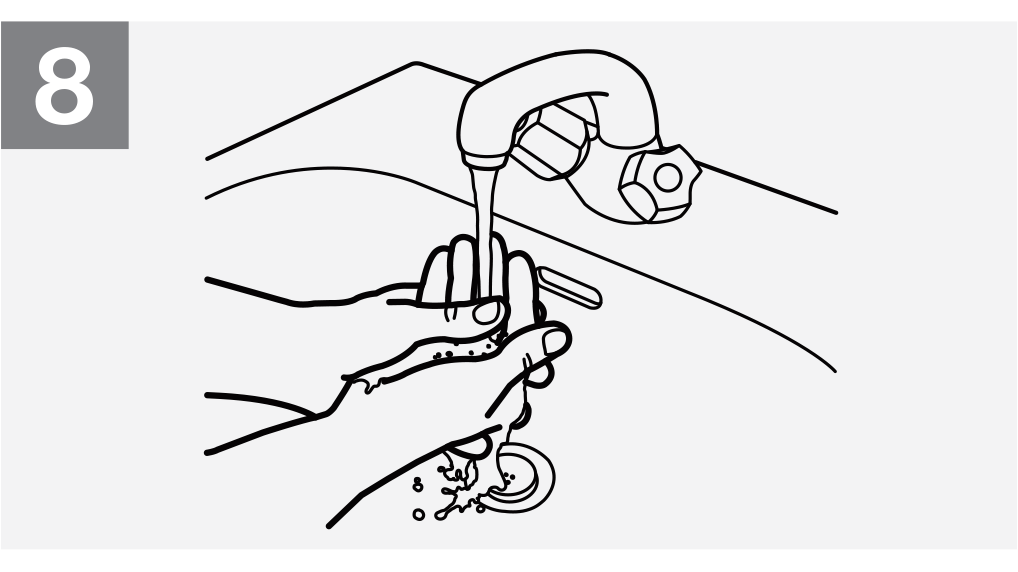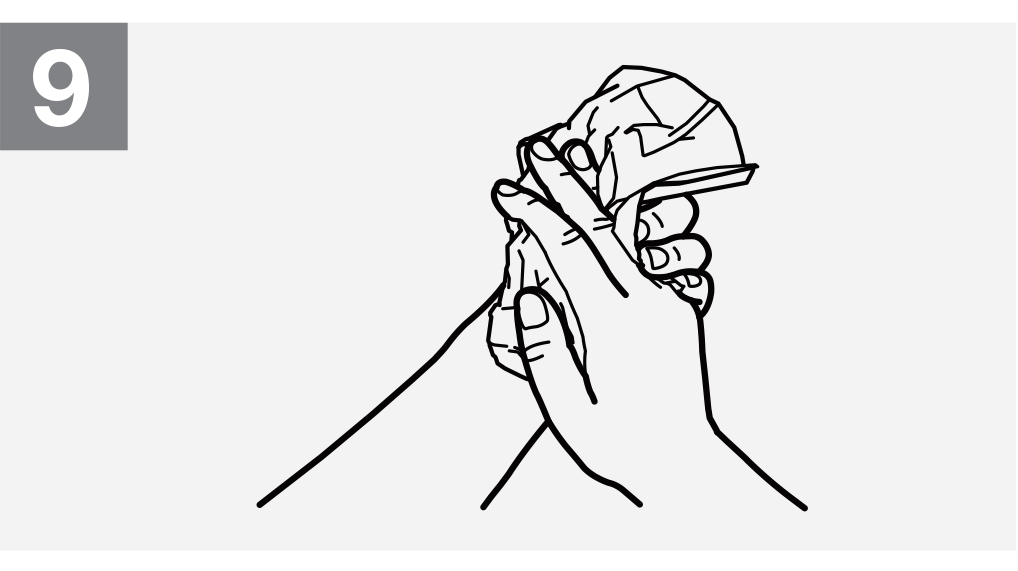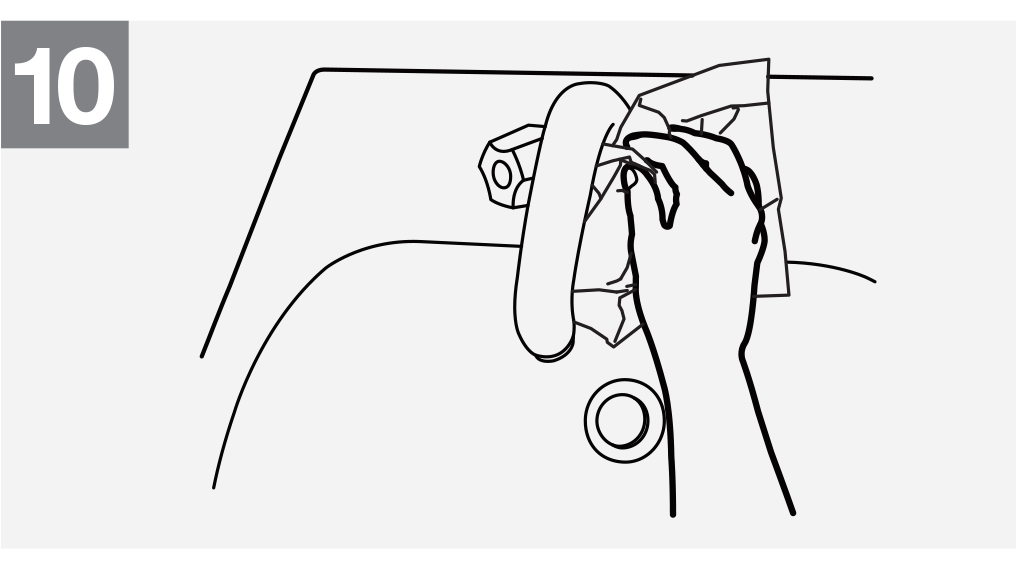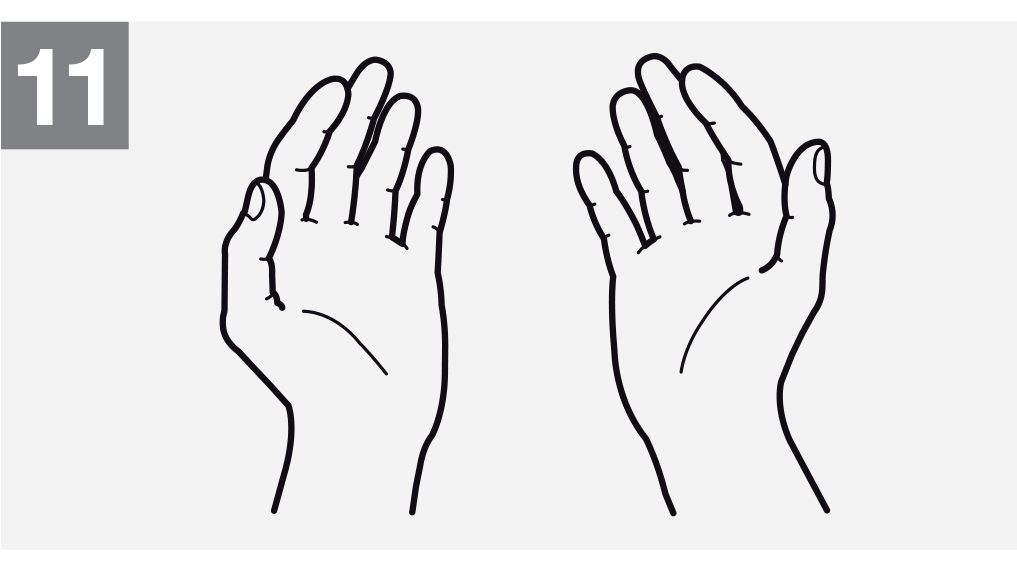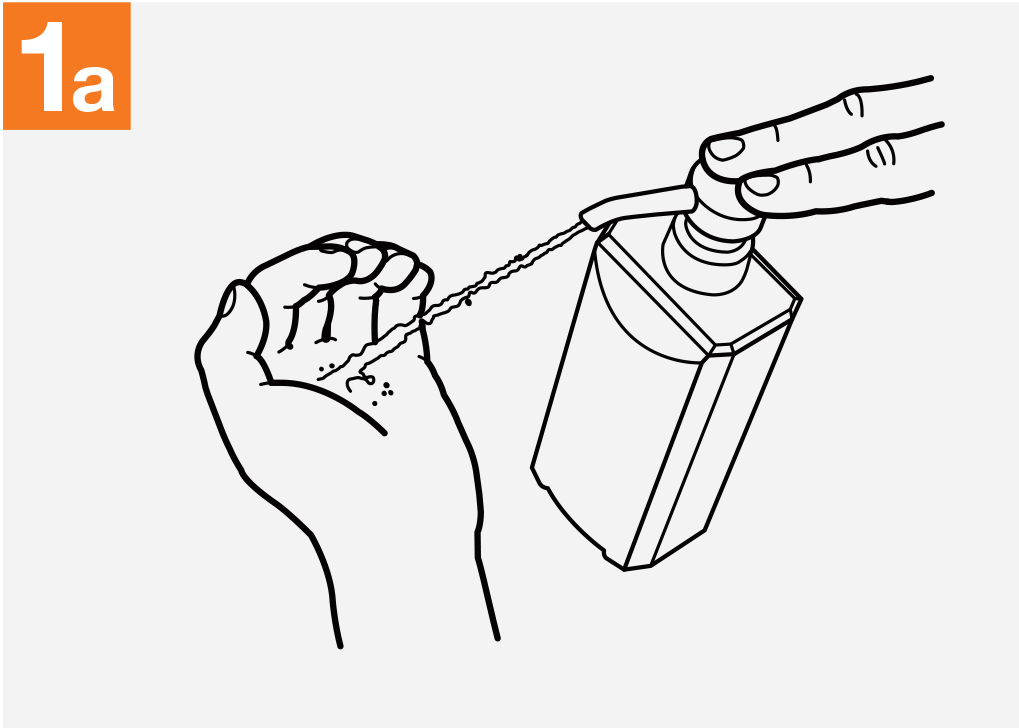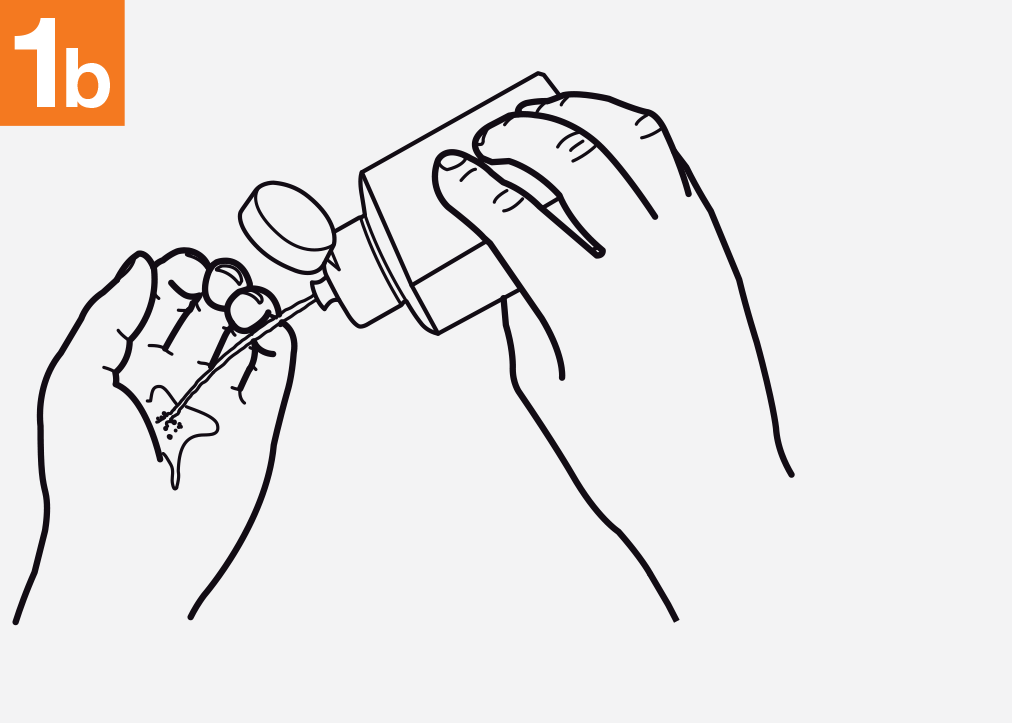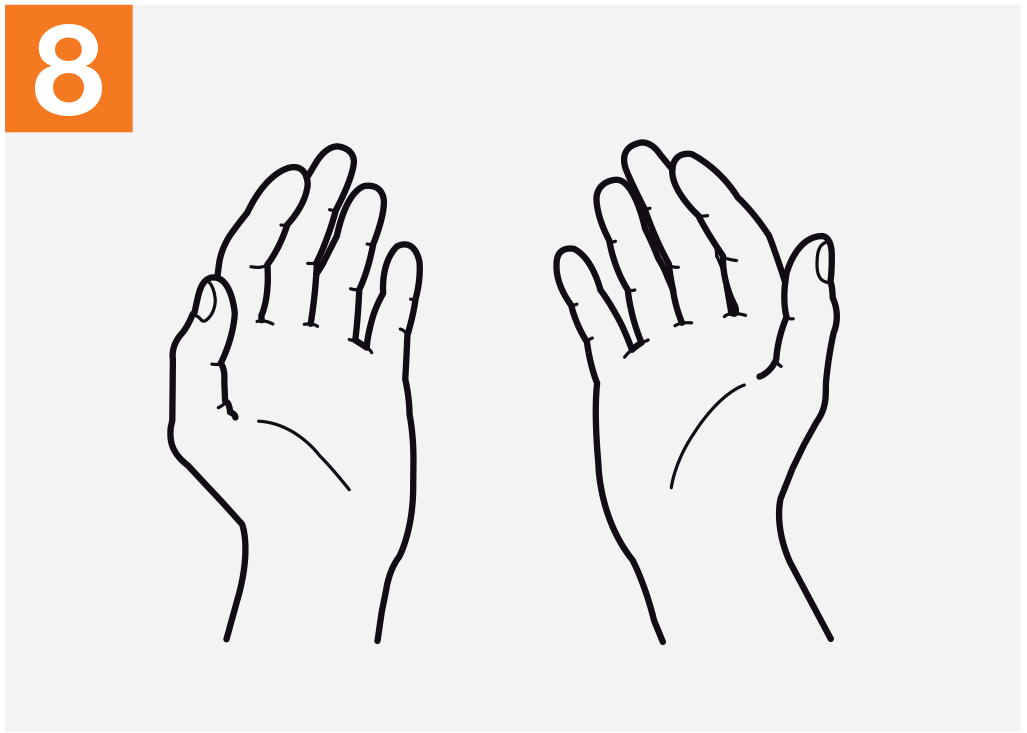Hand Hygiene
The hands of health care workers (HCWs) play a critical role in keeping patients safe. If HCWs do not clean their hands at the right moments, using the proper methods, they can transmit infection-causing microorganisms through their hands from one patient to another. Performing hand hygiene at key moments is an important health care intervention. Hand hygiene reduces the transmission of microorganisms (including those that are antibiotic-resistant), increases patient safety, and decreases health care-associated infection (HAI). Effective, timely hand hygiene is a cornerstone of infection prevention and control.
Learning Objectives
- Describe hand hygiene as a critical component of infection prevention and control.
- Identify the 5 Moments for Hand Hygiene.
- Discuss glove use and hand hygiene during patient care activities.
- Demonstrate the correct way to wash hands with soap and water according to the WHO-recommended method.
- Demonstrate the correct way to perform hand hygiene with an alcohol-based hand rub (ABHR) according to the WHO-recommended method.
- Discuss key issues and considerations of hand hygiene in a health care facility.
Learning Activities
-
Hand Hygiene During Rounds (5 min)
It is 10:00 on a Tuesday morning, and it is time for rounds in the surgical ward. It is your first day as the hospital IPC focal person. You decide to join the rounding team to observe and get to know routine practices on the ward. The physical layout of the surgical ward and the patient profiles for this particular day are shown below.
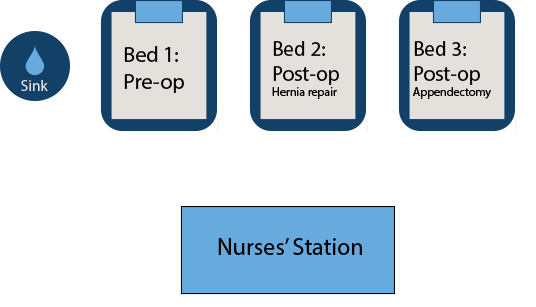
Dr Lim is the physician leading rounds today. He is joined by one resident and one medical student. Also on rounds is the surgical ward nurse.
You notice during rounds that there are a number of moments when hand hygiene should be performed. You decide to review rounds as a chance to reinforce hand hygiene practices among health care workers in the surgical ward.
-
The Purpose of Hand Hygiene (10 min)
In the health care environment microorganisms, such as bacteria, viruses and fungi, are transmitted through various routes. If not cleaned at the right moments, using the proper methods, the hands of HCWs play an important role in spreading microorganisms between patients. Timely hand hygiene also prevents contamination of the health care environment (e.g., linens, surfaces, patient care devices). The 5 Moments approach is designed to stop transmission at all of the key moments to keep patients safe.
During patient care, our hands become progressively colonized with microorganisms and potential pathogens. Lack of good hand hygiene increases the risk of contamination, and is a threat to patient safety. The purpose of good hand hygiene is to remove soil, organic material, and transient microorganisms from the hands. It does not eliminate the resident flora that live on the skin.
Hand hygiene is a general term that applies to either handwashing, handrubbing (e.g., using an alcohol-based hand rub), or surgical hand antisepsis. Hand hygiene is a simple but important procedure, yet its importance is often overlooked, even by HCWs. Timely and effective hand hygiene protects the patient, health care workers, and the health care environment from being contaminated by microorganisms that could be harmful pathogens.
By adhering to recommended hand hygiene practices, we can help protect patients by preventing infections from happening in the first place, and from spreading if they are already present. So, something that seems as simple as timely and effective hand hygiene can reduce the number of patients acquiring a health care-associated infection (HAI). Fewer HAIs means fewer resources spent on treating infections that could have been prevented, and ultimately, less morbidity and death. Fewer HAIs also reduces antibiotic use, which contributes to decreased antibiotic resistance. Therefore, hand hygiene is an essential health care intervention that saves both lives and money!
Now that you have learned about the role hand hygiene plays in limiting the spread of microorganisms, you decide to re-emphasize the purpose of hand hygiene with the surgical ward staff.
-
5 Moments for Hand Hygiene (15 min)
Health care workers should perform hand hygiene according to the World Health Organization’s (WHO) 5 Moments for Hand Hygiene. The WHO 5 Moments focuses on contact occurring within the patient zone during the delivery of patient care. It proposes a unified vision for all HCWs, trainers and observers to improve understanding of when to clean hands. It merges all hand hygiene indications recommended by the WHO Guidelines on Hand Hygiene in Health Care and CDC’s Guideline for Hand Hygiene in Health Care Settings into five moments when hand hygiene is required. Importantly, this user- and patient-centred approach aims for ease of use and integration into the natural workflow, which applies across a wide range of care settings and health care professions.
The patient zone includes the patient and some surfaces and items that are temporarily and exclusively dedicated to him/her (shown by the dotted line in the 5 Moments poster in Figure X-1). This typically includes the patient and all inanimate surfaces that are touched by or in direct physical contact with the patient, such as the bed rails, bedside table, bed linen, infusion tubing and other medical equipment. It further contains surfaces frequently touched by health care workers while caring for the patient, such as monitors, knobs and buttons, and other touch surfaces.Click or tap each arrow to discover more about each moment of hand hygiene.
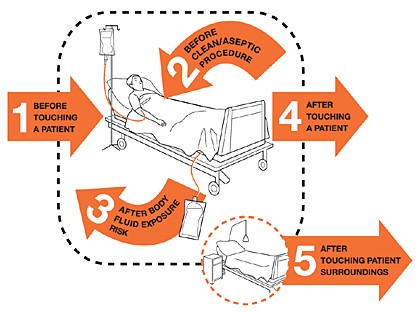
Moment 1. Before touching a patient
Clean your hands before touching a patient when approaching him/her to protect the patient against harmful germs carried on your hands.
Moment 2. Before a clean/aseptic procedure
Clean your hands immediately before accessing a critical site with infectious risk for the patient to protect the patient against harmful germs, including the patient’s own, entering his/her body.
Moment 3. After body fluid exposure risk
Clean your hands immediately after an exposure risk to body fluids (and after glove removal). This will protect both you and the health care environment from pathogens in blood and body fluids.
Moment 4. After touching a patient
Clean your hands after touching a patient and his/her immediate surroundings, and when leaving the patient’s side, to protect yourself and the health care environment from harmful microorganisms.
Moment 5. After touching patient’s surroundings
Clean your hands after touching any object or furniture in the patient’s immediate surroundings when leaving – even if the patient has not been touched – to prevent the spread of harmful microorganisms from inside the patient zone to the rest of the health care environment.
-
5 Moments in Action (20 min)
Now that you have learned about the 5 Moments for Hand Hygiene, let us go back to rounds on the surgical ward and add a little more detail. Think about the opportunities for hand hygiene at each patient’s bed. Let us start by reviewing the opportunities at Bed 1.

The patient in Bed 1 is a pre-op patient. The rounding team performed hand hygiene at the sink before entering the patient zone at Bed 1. Dr Lim gives a verbal consult on prophylactic antibiotics ahead of the surgery. The medical chart at the end of the bed is touched by the resident during the case review. The patient in Bed 1 is not touched. After the discussion, the team moves to Bed 2.
Use the slider to decide if any of the 5 moments apply to the patient care activities at Bed 1, and give an explanation in the text box below.
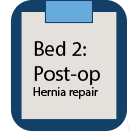
The patient in Bed 2 had abdominal surgery yesterday for a hernia repair. The medical student performed an abdominal examination. During the exam, the patient starts to feel unwell and vomits to the side of the bed. The nurse helps to clean up the vomit. After ensuring that the patient is stable, the rounding team moves on to Bed 3.
Use the slider below, decide if any of the 5 moments apply to the patient care activities at Bed 2 and give an explanation in the text box below.
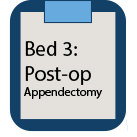
The patient in Bed 3 is recovering from an appendectomy. The patient is immobile and has a urinary catheter bag. During the rounds, Dr Lim handles the urinary catheter bag to check urine output. The resident changes the dressing on the central venous catheter. After these activities, the rounding team resumes other duties.
-
Gloves and Hand Hygiene (5 min)
Glove use is an important part of protecting hands from contamination. If an HCW is wearing gloves, it does NOT mean that hand hygiene can be skipped. In other words, glove use does NOT replace the need for hand hygiene. Considerations for hand hygiene and glove use include:
- Gloves are worn when contact is anticipated with blood or other body fluids, mucous membranes, non-intact skin, potentially infectious material, or chemicals (such as cleaning solutions).
- Hand hygiene is performed before putting on gloves.
- Remove gloves after caring for a patient. Do not wear the same pair of gloves for the care of more than one patient.
- When wearing gloves, remove gloves and perform hand hygiene during patient care if moving from a contaminated body site to another body site that is not contaminated (including a mucous membrane, non-intact skin, or a medical device within the same patient or the environment). An example of this is performing a wound dressing (non-intact skin) on the abdomen and then performing phlebotomy on the arm.
- Perform hand hygiene after glove removal. It is important to know that hand contamination often occurs during glove removal due to poor technique and also, possibly, as a result of small, undetected holes in gloves. Hands that are not clean when reaching into a box of gloves can spread microorganisms throughout the glove box. This is one reason why hand hygiene should always be performed before putting on and after taking off gloves.
You’ll learn more about gloves in the PPE module.
-
Cleaning Hands with Soap and Water (5 min)
The purpose of routine handwashing with soap and water is to remove dirt and organic material and microorganisms from the hands. Soap assists the mechanical removal of debris, loosely adherent microbes, and substances containing fats and oils that are often present on soiled hands. Plain soaps have minimal, if any, antimicrobial activity, though the friction from rubbing hands while washing hands with plain soap and water can remove loosely adherent transient flora.
It is important to spend the correct amount of time on handwashing – washing hands for 30 seconds has been shown to remove 10 times the amount of bacteria as washing them for 15 seconds. The entire handwashing procedure, if done correctly, should take 40 to 60 seconds.
The following slideshow explains step by step the proper way to wash hands with soap and water. Tap on the right arrow to go to the next image.
Washing hands with soap and water (rather than using alcohol-based hand rub) is recommended in the following situations:
- If hands are visibly dirty or soiled, or contaminated with blood or other body fluids.
- After using the toilet.
- When exposure to spore-forming pathogens, including outbreaks of Clostridium difficile (a bacterial infection that causes severe diarrhoea), is suspected or proven, as the friction from washing hands with soap and water will physically remove spores from hands.
-
Drying Hands (5 min)
Drying hands after using soap and water is an important step of in hand hygiene after using soap and water, because the transmission of microorganisms is more likely to occur with wet skin than with dry skin.
Dry hands thoroughly with a method that does not re-contaminate or irritate the hands, such as:
-
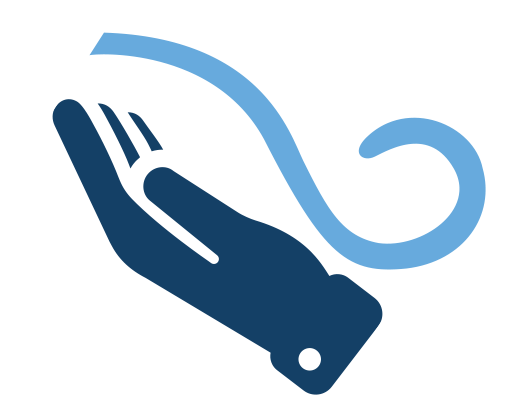 Air-drying (manual drying by movement of hands).
Air-drying (manual drying by movement of hands). -
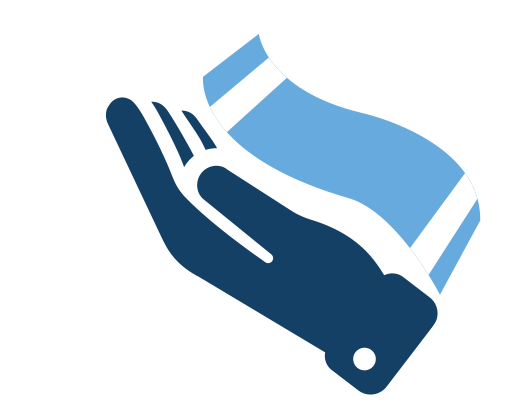 Using a paper towel or single-use cloth to pat hands dry—towels should not be used multiple times or by multiple individuals because shared towels quickly become contaminated.
Using a paper towel or single-use cloth to pat hands dry—towels should not be used multiple times or by multiple individuals because shared towels quickly become contaminated.
Warm-air dryers for drying hands are not recommended in health facilities, as forced air can result in the spread of pathogens through water droplets.
-
-
Demonstration (5 min)
In this video you will observe the proper soap-and-water handwashing technique, as well as proper hand drying. Pay attention, because in the next activity you will be asked to demonstrate this technique.
-
Practice with Soap and Water (5 min)
Now that you have learned about the proper way to wash your hands, practice this technique. Have a co-worker look at the Checklist for Handwashing Using Soap and Water and observe as you wash your hands. Ask him or her to give you feedback, then answer the questions below to check your understanding.
-
Cleaning Hands with Alcohol-based Hand Rub (5 min)
Alcohol-based hand rub is the preferred choice for hand hygiene if hands are not visibly soiled, because ABHR is more effective in killing microorganisms than plain or antimicrobial soaps and water, and it has other big advantages. The alcohol in ABHR kills microorganisms by denaturing proteins (i.e., they dissolve some microbe components). It also has persistent activity, meaning that it takes longer for microorganisms to repopulate the hands.
Hand hygiene with ABHR has advantages over hand hygiene with soap and water, including:
- It takes less time—only 20 to 30 seconds. In a very busy work environment, ABHR can save you time!
- ABHR can be placed directly at the point of care, making it convenient and easy to perform hand hygiene within your clinical workflow.
- Hand hygiene with ABHR does not need sinks, water, or towels—hands are air-dried.
It is important to note that the active ingredient—alcohol—is flammable, and that you should be careful and make sure any ABHR is stored away from flames.
The following slideshow shows the steps of How to Wash Hands with Alcohol-based Handrub. Tap on the right arrow to go to the next image.
You will find the WHO formulations for surgical hand preparation on the Resources page of this course.
-
Demonstration (5 min)
In this video you will observe the proper handrubbing technique using alcohol-based hand rub. Pay attention, because in the next activity you will be asked to demonstrate this technique.
-
Practice Hand Hygiene with Alcohol-Based Hand Rub (5 min)
Now that you’ve learned about proper ABHR application, practice this technique. Have a co-worker look at the Checklist for Hand Hygiene Using Alcohol-Based Hand Rub, and observe you as you apply ABHR to your hands. Ask him or her to give you feedback, then answer the questions below to check your understanding.
-
Facilities without Running Water (5 min)
For facilities without running water, low-cost, locally made systems can help ensure water is available for handwashing (see figure). Hand hygiene stations should be available both in clinical areas within the health care facility and in service areas (sterilization, laboratory, kitchen, laundry, showers, etc.). For handwashing, as long as soap is used, it is not necessary that the quality of water meet drinking standards – although efforts should be made to use clean water.
For systems with water in closed containers, avoid dipping hands into the container, as this can contaminate the water. Instead, someone should pour water over the user’s hands. Soap should be arranged such that water does not pool around it, so the soap can dry thoroughly. Soap can be placed on a grate, or hung in a net or with a rope.
For systems with a tap, it is preferable to stop the flow of water without using hands (e.g., long-handled taps that can be turned off with an elbow).
Thoroughly clean and dry containers and buckets on a daily basis to avoid buildup of microorganisms. Extra units (containers and buckets) may be needed, since the system will otherwise not be available for use while being cleaned.
-
Additional Considerations (10 min)
Click or tap each picture to learn about additional considerations for hand hygiene.


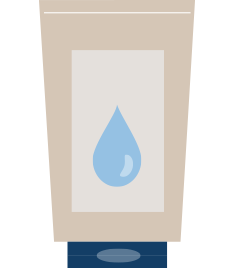

Lesions and Skin Breaks
To reduce the risks of skin reaction caused by frequent use of soap (such as contact dermatitis) and other skin damage, it is important to promote good skin-care practices that help to maintain skin integrity, such as:
- Discouraging concurrent use of soap and ABHR
- Promoting ABHR to protect skin integrity (frequent handwashing with soap can lead to contact dermatitis)
- Providing alternative hand hygiene products for HCWs who have confirmed allergies or adverse reactions to standard products used in the health care facility
Cuticles, hands, and forearms should be free of major lesions (such as ulcer, abscess and tumour) and cuts. Major cuts and abrasions should be covered with waterproof dressings. If you have active lesions, do not provide direct patient care or participate in surgery until they are healed.
Fingernails, nail polish and jewellery
Long fingernails, nail polish, and jewellery are impediments to hand hygiene and can promote bacterial growth on hands. Spaces or crevices under artificial or long nails and jewellery are hard to clean, and limit access to those areas. Natural fingernails should be kept short, ideally not extending 0.5 cm (less than 1/4 inch) beyond the fingertips.
- Artificial nails or extenders are discouraged while working in clinical areas.
- If nail polish is worn, it should not be chipped.
- Wearing jewellery, including rings, is strongly discouraged. As an alternative, rings can be placed on a necklace around the neck.
- Surgical teams should remove jewellery, including rings, bracelets and watches prior to performing surgical hand scrub.
Hand lotions and creams
Hand lotions and creams should be used with caution. If used as a shared product, lotion and cream tubes can lead to cross-contamination. Hand lotions, creams, or moisturizing skin care products are used to minimize hand hygiene-related dryness and contact dermatitis due to frequent handwashing. Oil-based hand creams that contain petroleum jelly should not be used, because they may damage latex rubber gloves.
Religious and cultural considerations
The health care facility’s IPC team should have discussions with staff to identify and address any religious concerns regarding hand hygiene and the products used for hand hygiene. The IPC team should seek advice from religious leaders and provide alternatives that are religiously acceptable to the staff.
-
Summary (5 min)
Hand hygiene is a critical component of infection prevention and control. This module has detailed how performing hand hygiene at the right moments can help to prevent the spread of harmful microorganisms. By identifying and applying the WHO 5 Moments of Hand Hygiene in your health care facility, you can understand why hand hygiene must be performed at those critical moments. You can now demonstrate proper hand hygiene techniques with both soap and water and ABHR.
In this module, we have also discussed special considerations for facilities without running water, as well as other materials, substances, or beliefs that may impact hand hygiene in your facility. Understanding how to incorporate good hand hygiene practices in your facility will strengthen the efficiency of your IPC programme.


